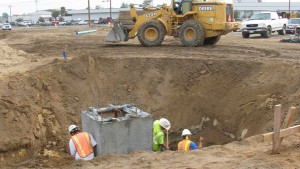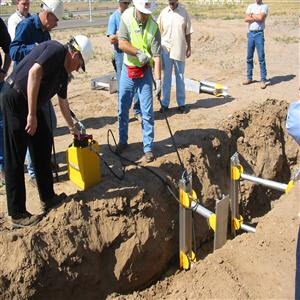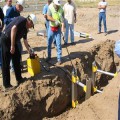 Following correct safety protocols when excavating is critical. According to a report by Osha, two workers are killed every month due to trench collapse.
Following correct safety protocols when excavating is critical. According to a report by Osha, two workers are killed every month due to trench collapse.
Keeping the crew safe should be a priority, but often safety protocols are overlooked or ignored for convenience or deadline completion.
In this article we will take a look at the top 5 excavating safety tips.
Create safe trenches
This is the most important safety measure as failure to follow these guidelines can result in trench collapse. All additional safety measures should be followed in addition to those listed here:
- Shoring: Installation of supports (typically hydraulics) to brace soil and prevent collapse.
- Benching: Installation of steps providing safe access and exits for the trench areas.
- Shielding: Installation of steel or aluminum protective structures around workers in the trench.
- Sloping: The process of digging the trench wall at an angle, sloping away from the excavation.
 Know the soil you are working with
Know the soil you are working with
Each cubic yard of soil can weigh as much as a 3,000 pound car. Depending on the type of soil the crew is working with, workers may have to slope, bench or shore the trench.
Soil classification should be performed by a knowledgeable, competent worker. Failing to properly follow these guidelines can result in a tragic cave-in.
Keep heavy equipment at a distance
Heavy equipment should be distanced from the sides of the trench, as far away as possible. Removed soil and other materials should be kept a minimum of two feet away from the edge – more if possible.
If the terrain does not allow for two feet of clearance, soil should be moved to another location.
Follow proper testing protocols: Once a trench has reached the four-foot mark, atmospheric testing should be performed. Trenches that show any signs of harmful gases, low oxygen levels or hazardous fumes should not be entered until properly dealt with.
Provide safe access to and from trenches: If trenches are more than four feet deep, additional requirements apply. Safe entrances and exits should include the implementation of ladders, ramps or steps. Ladders must extend above the trench surface a minimum of three feet.
Conclusion
Failure to adhere to safety guidelines may result in trench collapse. The loss of life is simply not worth bypassing regulations in an attempt to beat a deadline.
Employers should educate workers on excavating regulations, dangers and security measures, and reminders should be given in the form of memos, brochures and posted signs. Trench collapse can be prevented by proper training and implementation of security protocol.
